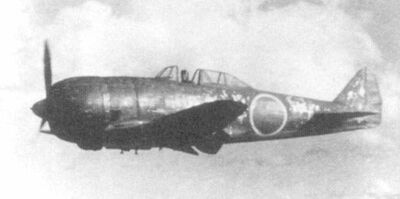
The Nakajima Ki-44 Shoki, allied codename Tojo, was designed to be the replacement for the Nakajima Ki-43 Hayabusa, the flag ship plane of the Japanese Air Force. Like the Ki-43 it was an all metal construction with retractable landing gear.
History[]
The first flight of the prototype was in August 1940, until the end of production in the year 1944, 1,223 aircraft were built. Diverging from the Japanese doctrine of high manoeuvreability, the Ki-44 was designed as an Interceptor aircraft with a good rate of climb and a high speed. Even if the flight performance had priority, the manoeuvreability was comparable to western fighters. U.S. fighters were also designed to have good flight performance but because of the Shoki's small size and light weight it was competitive, if not superior.
Even though the Ki-44 prevailed in combat against many fighters of the USAAF because

of its good flight performance, it was somewhat less successful in its role as a bomber interceptor.
The reasons were:
- Though it was designed pre-war as an Interceptor it lacked enough high speed for late WW2.
- Because of an unreliable engine the Ki 44-I had marginal high altitude performance like many Japanese fighters, but the Ki 44-II had a better reliable engine. However, it was still limited up high.
- The late war American B-29 Superfortress was too fast at high altitude.
- The insufficient armament was only two 7.7 mm and two 12.7 mm or four 12.7 mm machine guns, as a rule.
The Ki-44 was upgraded with:
- two 20 mm or 37 mm cannons in the wings and two 12.7 mm machine guns in the nose. Some say four 20 mm cannons.
- two 40 mm cannons and two machine guns. But soon these 40 mm cannons were swapped for Two more 12.7 mm guns by the pilots.
- A new engine for better high altitude flight with Turbocharger, but that was only used for testing, never in combat
- specially designed high altitude engine with three-gear gas compressor, also for testing only
The 20 mm or 37 mm cannon armament was the only upgrade that was successfully proven in combat. The 40 mm cannons had a very low Muzzle velocity and were only effective at a very short 150 m range. The bombers would be able to shoot down the Ki-44 too easily. They were ok for ground attack though. On the plus side, the 40 mm punched a whole in the B-29 1.5 m wide per hit! It had no recoil being caseless. It had the fastest rate of fire of any 40 mm cannon in the war at 450 r/m. This was nullified by the meager ammo supply of 10 rounds per cannon, so conservation meant very short bursts. It's no supprise many B-29s were rammed by some Ki 44 units.
While the production of the Ki-44 was cancelled for the new Nakajima Ki-84, production of the obsolete Nakajima Ki-43 was continued until the end of the War. The Ki-84 showed not only much greater performance, it was also better for mass production. Unfortunately it's engine was less reliable and was lacking at high altitudes also.
The 37 mm had 25 rounds per cannon. The 70th regiment had good success with this model of the Ki 44. This was offered in response to pilots requesting 20 mm cannons at least. It was a mistake to cancel the 376 mph Ki 44 now armed with cannons instead of the 358 mph Ki 43-IIIa. What could the Ki 43 do to a B-29 with two 12.7 mm guns? Japan needed cannon armed interceptors! The Ki 84 was stellar but needed the reliable high altitude 2,250 hp MK9C engine. It was slated for this upgrade but the sole MK9 engine factory was bombed. Another mistake was not producing them underground in a mountain like the Ki 84 was (in part).
The Ki 44 Shoki was unmatched in climb by the USA. Few Japanese fighters were faster, especially in a dive (well in excess of 500 mph). But to the Japanese pilots a full circle turn in 19 seconds was the worst, so it was last in horizontal tactics among their fighters. It tended to tail spin so some maneuvers were restricted. But vertical tactics were great. It had a hot landing speed and special care had to be taken to avoid a crash-landing with that big engine limiting forward view. However, in the air view was very good even to the rear. It was a good match for the P-38, but was outclassed by the P-51B which could turn inside it and best it on every other count but climb and roll perhaps. The Shoki deserved more production than it got. With larger quantities armed with cannons it may have even become more famous against B-29s.